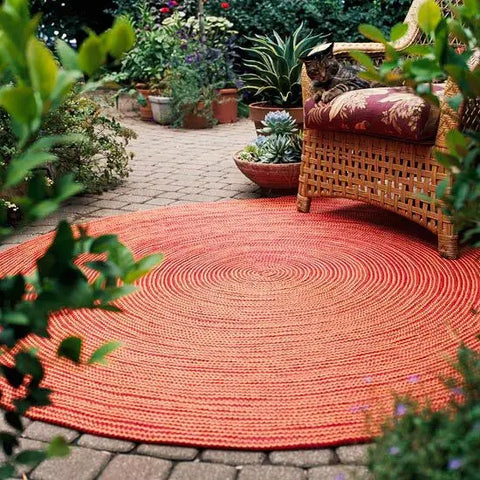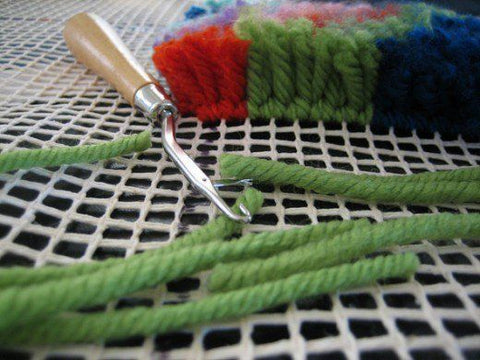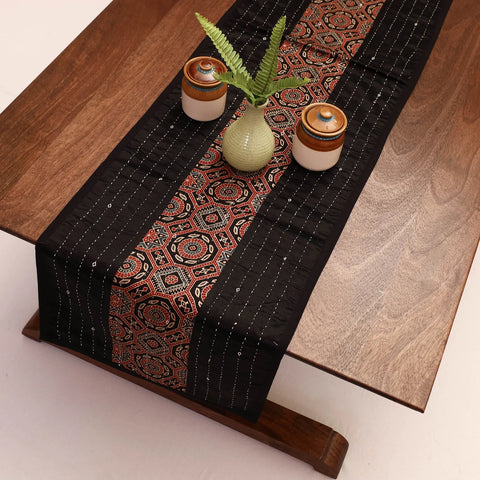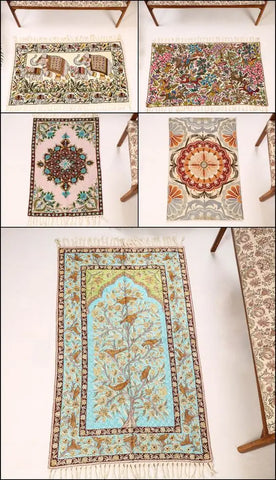Exploring the magical world of The Timeless Craft of Carpet Weaving we embark on a journey where every knot speaks of tradition and every thread has a story to tell. Carpet weaving is a story of patience and craftsmanship, from the ancient looms that ushered in the first carpet industry to the modern living rooms where this craft finds a welcome place.
Uncover the history of carpet weaving as we take you on a voyage across continents, eras, and civilizations, starting from the loom and ending in your living room.

History of Carpet Weaving
Carpet weaving has a long history, consequently, experts believe that carpet making has taken its root from the nomadic lifestyles of ancient tribes of Central Asia. Created out of the requirement to insulate against unbearable weather, these early carpets gradually developed into elaborate forms of art. Carpet weaving reached an unprecedented peak under the Persian civilization, and Safavid Dynasty masterpieces furnished benchmarks that were beyond time. The Silk Road created the possibility for exhibitions of weaving processes and thus affected the styles from a broad regional perspective. In Europe, during the Italian Renaissance, carpet trade was overwhelmed while the Industrial Revolution introduced mechanisation, making production a revolution. In the late 19th century, a new trend emerged in Arts and Crafts and it revived some aspects of hand-woven tradition and the carpet weavers. The history of carpets is now told all over the world in stories because their manufacture has steadily modernized, moving from artisanal workshops to itinerant looms to the contemporary carpet industry.
Process of Woven Carpets Or Rugs
Weaving carpets or rugs is an ancient craft that combines artistic expression, expertise, and tradition fascinatingly. The method, which has its roots in past customs, is carried out in a methodical manner that has been preserved over time in numerous areas of the world.
1. Design and Pattern Selection
The design and pattern selection process for woven carpet types or rugs requires a detailed process where the method is obtained by decoding from cultural heritage and contemporary trends. The carpet weavers then proceed to choose intricate themes and palettes for their works, resulting in visually appealing masterpieces that express both their design voices and the ancient tradition.

2. Material Selection
Material selection is a key step for weaving carpets and rugs, with a focus on luxury fibers such as silk, wool, or a combination of the two. Other than that durability, texture, and desired appearance are among the considerations that go into the process of carpet weaving.
3. Dyeing the Yarn
The use of both natural and synthetic dyes gives the yarn a colourful makeover which protects the environment while producing beautiful colours.
4. Warping and Loom Setting
The process of warping involves tightly stretching longitudinal threads on the loom, which creates the framework for carpets or rugs that are made. These warp strands are firmly held in place by the loom, a crucial tool in the weaving process that provides a sturdy canvas on which complex designs might develop.
5. Weaving Techniques
Many methods are used to weave carpets or rugs, such as hand-knotting, in which tiny knots are made around warp threads to create complex patterns. Reversible rugs with a smooth texture are produced by flatweave techniques like dhurrie or kilim weaving, while pile weaving produces a plush surface by looping yarn over the warp strands.

6. Trimming and Finishing
To attain a consistent pile height, expert weavers carefully trim the carpet after the weaving process. The woven carpet or rug's durability and aesthetic appeal are enhanced by the finishing touches, which also guarantee a polished and elegant result.
7. Washing and Drying
After weaving, the carpets or rugs are thoroughly cleaned to get rid of extra dye, contaminants, and sizing agents. In addition to ensuring cleanliness, this scrubbing procedure enables the fibers to fully absorb the vivid colours. Drying carefully preserves the final product's quality and artistry by either using controlled settings or natural air drying.
Types of Carpets Which Bring Aesthetic Touch to Your Living Room
We have listed for you some of the best picks in carpets that will add a dash of charm to your space and reflect your style and preferences
- Handblock Printing
Handblock printing has originated in East Asia and has been used for centuries. It requires carving blocks of wood, which are then dyed and repeatedly pressed onto a piece of cloth to create design patterns. This technique involves applying elaborate designs to textiles and carpets using handcrafted wooden pieces. The spontaneous and uneven nature of handpiece printing lends each rug a distinct and particular individuality, making it one of the most charming works of woven carpet types.
- Crochet Work
Crochet Weaving involves choosing the right yarn and rope size to create a thick carpet or rug. Starting from the lower chain, the chosen pattern of embroidery, such as single crochet or half-double crochet, is repeated to achieve the desired pattern and design. Careful color changes, if applicable; and consistent measurements ensure that the carpet reaches its intended thickness. Addressing loose ends by adding a finishing border completes the project. The resulting crochet carpet provides handmade and interchangeable furniture for any space.

- Ajrakh Block Printing
Ajrak or Ajrakh is a unique block-printed Indian carpet design that uses natural dyes and resist paste to produce gorgeous designs on fabrics. This carpet has distinct traditional motifs and designs. Typically, Ajrak is printed on both sides utilizing the resist printing method. Printing is done by hand, using hand-carved wooden blocks. The fabric is cleansed, steeped in castor oil and camel dung, carved onto wooden blocks, and then stamped onto the fabric to preserve the colour.

- Crewel Embroidery
Crewel embroidery is thousand years old decorative embroidery made of wool yarn on plain woven fabric. Typically using chain, wood and satin threads, crewelwork often features vibrant and dramatic floral or motifs, characterized by its rich colour palette from medieval Europe and popular in the century 17th century England.

- Modern Abstract Carpets
Modern abstract carpets with strong colours and avant-garde designs can serve as focus pieces in your living area, adding a contemporary touch. These beautiful pieces bring a touch of uniqueness and creativity to the decor.
- Kalamkari Block Printing Rug
Kalamkari block printing can only be identified by its name, which refers to the design created with a pen. It is a traditional block print technique that may be used on canvas, cotton, and silk fabrics. The design uses natural colours and a tamarind or bamboo pen. The phrase Kalamkari is derived from the Persian words kalam, which means pen, and kari, which indicates craftsmanship.
- Vintage Overdyed Carpets
are recycled ancient rugs that have been dyed to generate brilliant, modern colours while keeping the charm of age. These rugs add a unique blend of history and contemporary style to your living space.
Conclusion
Carpets tell rich stories about human inventiveness as they travel from the loom to the living room. These carpets are more than just floor coverings since they combine nomadic traditions with modern techniques. Carrying the tradition of artistry, they add a cultural dimension to homes and serve as bright testaments to the everlasting beauty of carpet making. Explore this legacy with iTokri, where a wide range of handmade Indian carpets await you to beautify your homes.
Revel in the artistry and tradition, and bring home a piece of history.
Frequently Asked Questions
1. Which Indian cities are famous for Handwoven Carpets?
Because of its Persian and ancient background, Bhadohi and Mirzapur, Uttar Pradesh, have been dubbed the Carpet City of India. Jaipur is well-known for its traditional Rajasthani patterns, whilst Varanasi specializes in striped silk carpets with unique designs.
2. How to care for rugs & Carpets?
You can Vacuum the rugs and carpets to remove dust and dirt. In the matter of a spill, wipe it off immediately with a clean cloth rather than rubbing.
3. What is the future of the carpet industry in India?
The carpet business in India appears to have bright futures in terms of merging centuries of tradition with cutting-edge technology.
 Verified Purchase
Verified Purchase
































Leave a comment (all fields required)